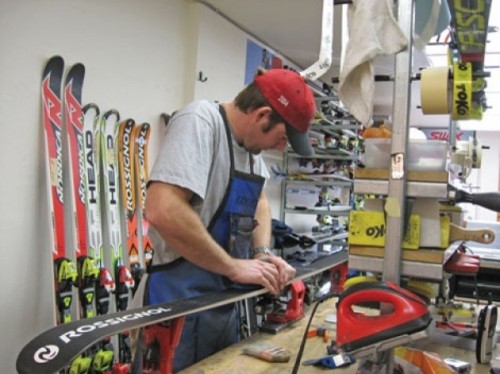He immediately went to the lodge for a wax job, after which his fast glide returned.
Caring for gear is essential for a good day on snow. Jeff Sadis, a top ski and snowboard tech, says, “Start by getting a base grind from a professional. The grind puts a pattern of grooves into the base of a ski or snowboard that helps it glide more easily over snowy surfaces. You have to think of it like you would a road tire: The groove pattern allows water to bead up and roll away.”
Sadis—who works at Sports Den in Foothill Village when he’s not tuning at elite races for athletes on various national teams—adds that another important part of tuning your gear is to have the edges sharpened to the right bevel, or angle. The correct angle is determined by your ability: Good snowriders use an “aggressive” or narrow bevel; beginners should have a more right-angled bevel.
“You don’t have to be a rocket scientist to tune your own gear. We offer clinics to teach people how to do it. A couple of sharp files and a bevel guide is really all you need to tune your edges at home,” Sadis says.
But the most important care you can give your gear is waxing. It should be done at least every other time you hit the slopes. Without wax, the bare base scrapes over the abrasive crystals of snow, forming fuzzy “hairs” that cause the base to ride sluggishly and react erratically during a turn. All the glide is gone.
You can use an all-temperature wax or go for a group of waxes for precise temperatures and snow conditions. You’ll need an iron to melt the wax and get it absorbed into the base. But forget about using a regular iron from a thrift store. “A clothes iron doesn’t maintain an accurate temperature,” Sadis explains.
Because bases burn easily, as does wax, you want an iron especially made for skis and snowboards. It holds the right temperature for melting the wax and opening the pores of the base so it can be ironed in. The wax embedded in the base is what makes the job last. You can purchase a good wax iron for as little as $40.
Start by placing the gear on a flat surface, base up, and brushing the base (with a base brush, of course; about $18) hard for several minutes. This removes dirt, pollen and grooming-machine residue that the gear absorbs as it rides over the snow pollution. Wipe the particles off with a rag. Next, rub the bar of wax all over the base. This gives a protective layer against the direct heat of the iron.
Holding the iron about six inches above the base, put the bar of wax against the iron and drip a plentiful supply of wax all along the base. Run the iron slowly along the drips of wax until they melt into a shiny layer. Run the iron from one end to the other. Don’t move it in a circle—that scratches the base.
After about five minutes of waxing, feel the upside-down top of the ski or snowboard. It should feel slightly warm. If the wax stays shiny wet for at least 30 seconds after you’ve removed the iron, you’ve ironed enough.
Let the wax cool for at least several hours, then scrape it off, using one of the cheap plastic scrapers made for the job. Use a brush to get the wax particles out of the grooves if you want to go faster—as in, fast enough to get more air. Hit the slopes on your tuned and waxed gear, and be ready for a wonderful time.
More by Wina Sturgeon
-
Conquer the Superpipe
Some advice to help you take the plunge
- Jan 8, 2013
-
Park City Shortcuts
Bypass the traffic and be on your way
- Dec 24, 2012
-
Ride the Terrain Park
Start learning or polish your skills
- Dec 11, 2012
- More »



